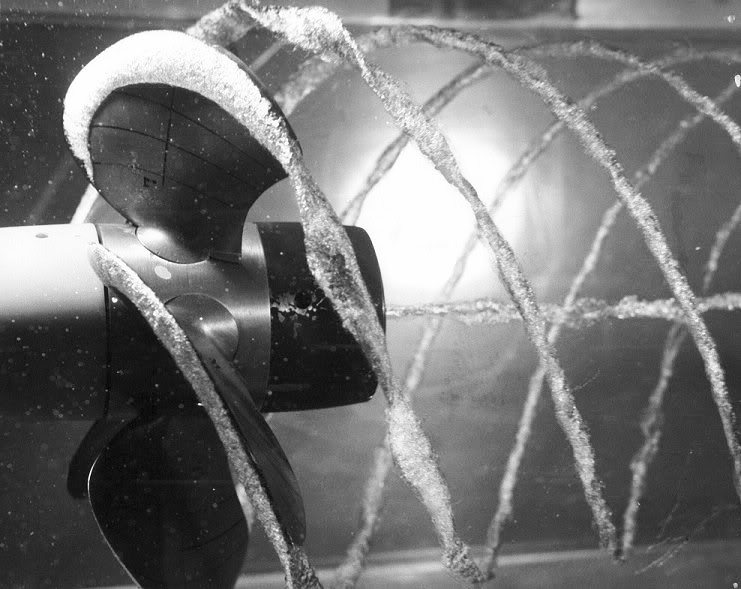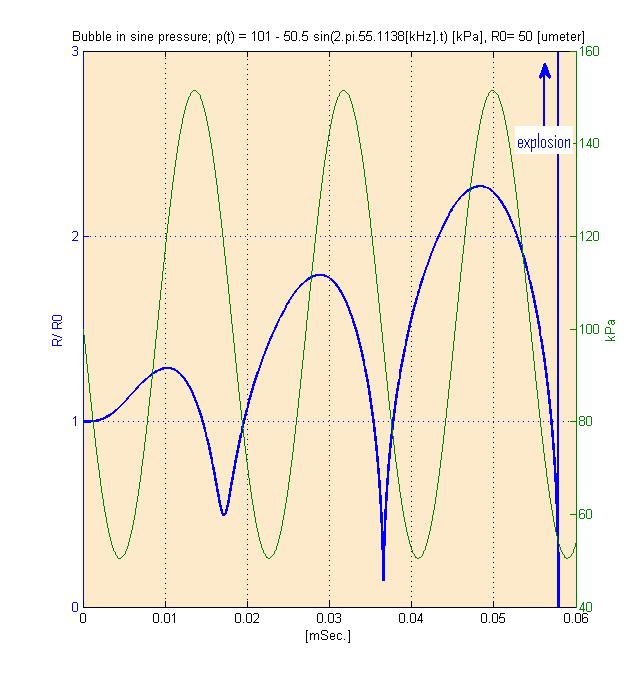Rayleigh–Plesset Equation on:
[Wikipedia]
[Google]
[Amazon]
 In
In
 The Rayleigh–Plesset equation can be derived entirely from
The Rayleigh–Plesset equation can be derived entirely from
 In
In fluid mechanics
Fluid mechanics is the branch of physics concerned with the mechanics of fluids (liquids, gases, and plasmas) and the forces on them.
It has applications in a wide range of disciplines, including mechanical, aerospace, civil, chemical and ...
, the Rayleigh–Plesset equation or Besant–Rayleigh–Plesset equation is an ordinary differential equation
In mathematics, an ordinary differential equation (ODE) is a differential equation whose unknown(s) consists of one (or more) function(s) of one variable and involves the derivatives of those functions. The term ''ordinary'' is used in contras ...
which governs the dynamics of a spherical bubble
Bubble, Bubbles or The Bubble may refer to:
Common uses
* Bubble (physics), a globule of one substance in another, usually gas in a liquid
** Soap bubble
* Economic bubble, a situation where asset prices are much higher than underlying fundame ...
in an infinite body of incompressible fluid. Its general form is usually written as
:
where
: is the density
Density (volumetric mass density or specific mass) is the substance's mass per unit of volume. The symbol most often used for density is ''ρ'' (the lower case Greek letter rho), although the Latin letter ''D'' can also be used. Mathematicall ...
of the surrounding liquid, assumed to be constant
: is the radius of the bubble
: is the kinematic viscosity
The viscosity of a fluid is a measure of its resistance to deformation at a given rate. For liquids, it corresponds to the informal concept of "thickness": for example, syrup has a higher viscosity than water.
Viscosity quantifies the intern ...
of the surrounding liquid, assumed to be constant
: is the surface tension of the bubble-liquid interface
:, in which, is the pressure
Pressure (symbol: ''p'' or ''P'') is the force applied perpendicular to the surface of an object per unit area over which that force is distributed. Gauge pressure (also spelled ''gage'' pressure)The preferred spelling varies by country a ...
within the bubble, assumed to be uniform and is the external pressure infinitely far from the bubble
Provided that is known and is given, the Rayleigh–Plesset equation can be used to solve for the time-varying bubble radius .
The Rayleigh–Plesset equation is derived from the Navier–Stokes equations
In physics, the Navier–Stokes equations ( ) are partial differential equations which describe the motion of viscous fluid substances, named after French engineer and physicist Claude-Louis Navier and Anglo-Irish physicist and mathematician G ...
under the assumption of spherical symmetry
In geometry, circular symmetry is a type of continuous symmetry for a planar object that can be rotated by any arbitrary angle and map onto itself.
Rotational circular symmetry is isomorphic with the circle group in the complex plane, or t ...
.
History
Neglecting surface tension and viscosity, the equation was first derived by W. H. Besant in his 1859 book with the problem statement stated as ''An infinite mass of homogenous incompressible fluid acted upon by no forces is at rest, and a spherical portion of the fluid is suddenly annihilated; it is required to find the instantaneous alteration of pressure at any point of the mass, and the time in which the cavity will be filled up, the pressure at an infinite distance being supposed to remain constant'' (in fact, Besant attributes the problem to Cambridge Senate-House problems of 1847).Besant, W. H. (1859). A treatise on hydrostatics and hydrodynamics. Deighton, Bell. Article. 158. Neglecting the pressure variations inside the bubble, Besant predicted the time required to fill the cavity to be : where the integration was carried out byLord Rayleigh
John William Strutt, 3rd Baron Rayleigh, (; 12 November 1842 – 30 June 1919) was an English mathematician and physicist who made extensive contributions to science. He spent all of his academic career at the University of Cambridge. Amo ...
in 1917, who derived the equation from energy balance. Rayleigh also realized that the assumption of constant pressure inside the cavity would become wrong as the radius decreases and he shows that using Boyle's law
Boyle's law, also referred to as the Boyle–Mariotte law, or Mariotte's law (especially in France), is an experimental gas law that describes the relationship between pressure and volume of a confined gas. Boyle's law has been stated as:
Th ...
, if the radius of cavity decreases by a factor of , then the pressure near the boundary of the cavity becomes greater than the ambient pressure. The equation was first applied to traveling cavitation
Cavitation is a phenomenon in which the static pressure of a liquid reduces to below the liquid's vapour pressure, leading to the formation of small vapor-filled cavities in the liquid. When subjected to higher pressure, these cavities, cal ...
bubbles by Milton S. Plesset
Milton Spinoza Plesset (7 February 1908 – 19 February 1991) was an American applied physicist who worked in the field of fluid mechanics and nuclear energy. He was elected to the National Academy of Engineering in 1979 for his fundamental contr ...
in 1949 by including effects of surface tension.
Derivation
 The Rayleigh–Plesset equation can be derived entirely from
The Rayleigh–Plesset equation can be derived entirely from first principle
In philosophy and science, a first principle is a basic proposition or assumption that cannot be deduced from any other proposition or assumption.
First principles in philosophy are from First Cause attitudes and taught by Aristotelians, and nuan ...
s using the bubble radius as the dynamic parameter. Consider a spherical
A sphere () is a geometrical object that is a three-dimensional analogue to a two-dimensional circle. A sphere is the set of points that are all at the same distance from a given point in three-dimensional space.. That given point is the ...
bubble with time-dependent radius , where is time. Assume that the bubble contains a homogeneously distributed vapor/gas with a uniform temperature and pressure . Outside the bubble is an infinite domain of liquid with constant density and dynamic viscosity
The viscosity of a fluid is a measure of its resistance to deformation at a given rate. For liquids, it corresponds to the informal concept of "thickness": for example, syrup has a higher viscosity than water.
Viscosity quantifies the inte ...
. Let the temperature and pressure far from the bubble be and . The temperature is assumed to be constant. At a radial distance from the center of the bubble, the varying liquid properties are pressure , temperature , and radially outward velocity . Note that these liquid properties are only defined outside the bubble, for .
Mass conservation
Byconservation of mass
In physics and chemistry, the law of conservation of mass or principle of mass conservation states that for any system closed to all transfers of matter and energy, the mass of the system must remain constant over time, as the system's mass ca ...
, the inverse-square law
In science, an inverse-square law is any scientific law stating that a specified physical quantity is inversely proportional to the square of the distance from the source of that physical quantity. The fundamental cause for this can be unde ...
requires that the radially outward velocity must be inversely proportional to the square of the distance from the origin (the center of the bubble). Therefore, letting be some function of time,
:
In the case of zero mass transport across the bubble surface, the velocity at the interface must be
:
which gives that
:
In the case where mass transport occurs, the rate of mass increase inside the bubble is given by
:
with being the volume of the bubble. If is the velocity of the liquid relative to the bubble at , then the mass entering the bubble is given by
:
with being the surface area of the bubble. Now by conservation of mass , therefore . Hence
:
Therefore
:
In many cases, the liquid density is much greater than the vapor density, , so that can be approximated by the original zero mass transfer form , so that
:
Momentum conservation
Assuming that the liquid is aNewtonian fluid
A Newtonian fluid is a fluid in which the viscous stress tensor, viscous stresses arising from its Fluid dynamics, flow are at every point linearly correlated to the local strain rate — the derivative (mathematics), rate of change of its deforma ...
, the incompressible Navier–Stokes equation in spherical coordinate
In mathematics, a spherical coordinate system is a coordinate system for three-dimensional space where the position of a point is specified by three numbers: the ''radial distance'' of that point from a fixed origin, its ''polar angle'' mea ...
s for motion in the radial direction gives
: